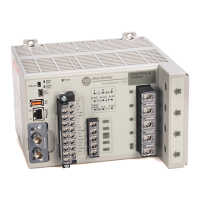460 Rockwell Automation Publication 1426-UM001J-EN-P - August 2019
Appendix F IEEE 519 Pass/Fail and TDD
Application
This standard applies to the M6 and M8 models.
Setup
Basic Metering setup is required. Three configuration parameters that are
required for calculating the IEEE 519 Pass/Fail requirements are found in the
Configuration.PowerQuality tab.
• IEEE519_Compliance_Parameter - Selects 0 = current (default) or 1 =
voltage as the compliance parameter.
• IEEE519_MAX_Isc_Amps - Short circuit current available at the PCC,
in Amps. Default = 0
• IEEE519_MAX_IL_Amps - Average current related to the maximum
demand for the preceding 12 months. Default = 0
IEEE 519 Pass/Fail Results
The PowerMonitor™ 5000 reports the IEEE 519 pass/fail status for short-term
and long-term conditions in the Status.Alarms
table in the tags that are listed. If
the values of IEEE519_MAX_Isc_Amps = 0 or IEEE519_MAX_IL_Amps = 0,
then the first row in Table 225
IEEE 519 Current Distortion Limits is used to
measure compliance. If the value of IEEE519_MAX_IL_Amps = 0, then current
THD rather than TDD is used to measure compliance.
IEEE519_Overall_Status
This bitfield reports overall status.
0 = PASS
1 = FAIL
• Bit0 - ShortTerm_TDD_THD_PASS_FAIL
• Bit1 - LongTerm_TDD_THD_PASS_FAIL
• Bit2 - ShortTerm_Individual_Harmonic_PASS_FAIL
• Bit3 - LongTerm_Individual_Harmonic_PASS_FAIL
• Bit4 … 15 - Future Use
• ShortTerm_2nd_To_17th_Harmonic_Status
• LongTerm_2nd_To_17th_Harmonic_Status
Table 226 - IEEE 519 Voltage Distortion Limits (0…69 kV)
Individual voltage distortion, % Total voltage THD, %
3.0 5.0
IMPORTANT Zero values for Max Isc and IL disable the calculation.

